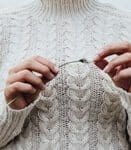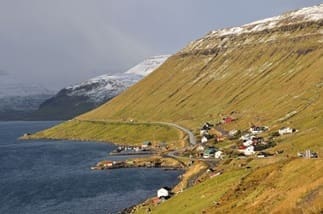The Faroe or Faeroe Islands are a North Atlantic archipelago located 320 kilometres north-northwest of Scotland, and about halfway between Norway and Iceland. It is an autonomous territory within the Kingdom of Denmark. The islands have a total area of about 1,400 square kilometres with a population of 52,656 as of August 2020. Faroese is spoken in the entire area as a first language. The domestic animals of the Faroe Islands are a result of 1,200 years of isolated breeding. As a result, many of the islands’ domestic animals are found nowhere else in the world. Faroese domestic breeds include Faroe pony, Faroe cow, Faroe sheep, Faroese goose, and Faroese duck.
Faroese handicrafts are mainly based on materials available to local villages – mainly wool. Garments include sweaters, scarves, and gloves. There has recently been a strong revival of interest in Faroese knitting, with young people knitting and wearing updated versions of old patterns emphasized by strong colours and bold patterns.

Faroe knitting
TEXTILE OF FAROE
The Faroe Islands are home to a vibrant knitting culture, one that’s about to find its way into more yarn shops and knitting bags on the west side of the Atlantic. The story of Faroese wool is a long one, dating back more than one thousand years, and involves Irish monks, Vikings, textile anthropology, and lots and lots of sheep. A bit of geography and history to start: The Faroe Islands are a tiny archipelago of 18 islands located in the North Atlantic about halfway between Iceland and Norway. Faroe is a self-governing region that falls under the jurisdiction of the Kingdom of Denmark, although it has its own parliament and flag. Archaeological evidence from the Faroes shows that people inhabited the islands as early as 300 CE, but their identity remains a mystery. Later, it appears that Irish monks settled the islands but were eventually driven out by Vikings.
By the time the Vikings arrived with their own sheep, the islands already had healthy herds. The ovine population must have been impressive because the Vikings are said to have named their new home “sheep islands” in Old Norse. A ram figures centrally on the Faroese coat of arms, showing how important the meat, milk, skin, and wool from sheep have been to the inhabitants of this cold, windswept place.

Faroe sheep
These days, Faroese sheep outnumber people at a ratio of about eight sheep to every five humans, and many families raise small herds. The Faroese sheep are a hardy bunch with small bones and long outer coats over soft, downy undercoats— and they look a bit like wool batts on legs. The fibre itself is like the environment in which it’s grown – beautiful. Like wool in the United States and United Kingdom, Faroese wool fell on hard times when global wool prices plummeted, and people began favouring synthetic fabrics such as Gore-Tex and polyester fleece. Heartbroken by the bonfires farmers ignited throughout the Faroes to burn their unsalable wool and searched for a fashionable use for by-products of the local sheep industry. They initially designed lambskin coats, but they shifted their focus to knitwear after Japanese buyers took an avid interest in Ludwig’s knits at a trade show. Today, wool from the island is used along with natural fibres sourced from other regions. It also works with a women’s knitting cooperative in Peru and hires Jordanian women, who have few employment opportunities outside the home, to knit.
TRADITIONAL DRESS OF FAROE
The traditional Faroese national dress is also a local handicraft that people spend a lot of time, money, and effort to assemble. It is worn at weddings and traditional dancing events, and on feast days. The cultural significance of the garment should not be underestimated, both as an expression of local and national identity and a passing on and reinforcing of traditional skills that bind local communities together. A young Faroese person is normally handed down a set of children’s Faroese clothes that have passed from generation to generation. Children are confirmed at age 14, and normally start to collect the pieces to make an adult outfit, which is considered as a rite of passage. Traditionally the aim would have been to complete the outfit by the time a young person was ready to marry and wear the clothes at the ceremony—though it is mainly only men who do this now.

Faroese national dress
Each piece is intricately hand-knitted, dyed, woven or embroidered to the specifications of the wearer. For example, the man’s waistcoat is put together by hand in bright blue, red or black fine wool. The front is then intricately embroidered with colourful silk threads, often by a female relative. The motifs are often local Faroese flowers or herbs. After this, a row of Faroese-made solid silver buttons are sewn on the outfit.
Women wear embroidered silk, cotton or wool shawls and pinafores that can take months to weave or embroider with local flora and fauna. They are also adorned with a hand-woven black and red ankle-length skirt, knitted black and red jumper, a velvet belt, and black 18th century style shoes with silver buckles. The outfit is held together by a row of solid silver buttons, silver chains and locally-made silver brooches and belt buckles, often fashioned with Viking style motifs. Both men’s and women’s national dress are extremely costly and can take many years to assemble. Women in the family often work together to assemble the outfits, including knitting the close-fitting jumpers, weaving and embroidering, sewing and assembling the national dress. This tradition binds together families, passes on traditional crafts, and reinforces the Faroese culture of traditional village life in the context of a modern society.
References
https://en.wikipedia.org/wiki/Faroe_Islands
https://www.interweave.com/article/knitting/faroe-islands-native-yarn/
https://www.theguardian.com/lifeandstyle/2014/may/07/craft-faroe-islands-wool-sarah-lund-killing
Article compiled by
Shruti Ragunathan
Business Development Intern at TVC
Master of Fashion Management
National Institute of Fashion Technology

